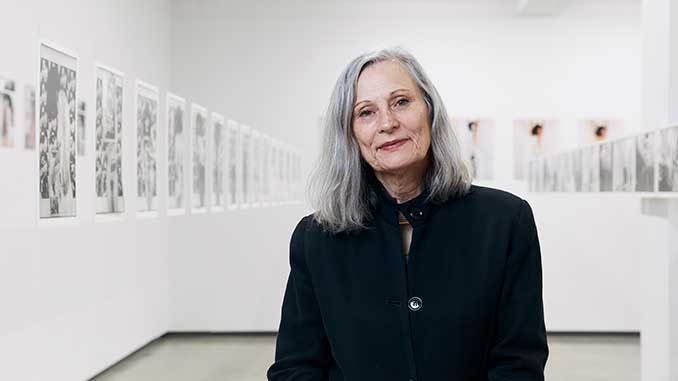 A major figure in Australian contemporary art for over 40 years, the Museum of Contemporary Art Australia (MCA Australia) presents Julie Rrap: Past Continuous.
A major figure in Australian contemporary art for over 40 years, the Museum of Contemporary Art Australia (MCA Australia) presents Julie Rrap: Past Continuous.
Since the mid-1970s, Rrap has used photography, video, performance, sculpture, and drawing, to examine representations of the female body in art and popular culture over time, often using her own body as the subject.
Julie Rrap: Past Continuous at MCA Australia presents the artist’s landmark installation Disclosures: A Photographic Construct (1982) from the MCA Collection, in dialogue with new and recent works of video, sculpture, and photography, using the artist’s body 42 years later.
This exhibition is part of an ongoing program that presents new work by living Australian artists drawing upon emblematic works in the MCA Collection.
Disclosures: A Photographic Construct (1982) comprises over 70 photographs and self-portraits taken in the artist’s studio. Suspended in rows of opposing perspectives, Rrap builds a dialogue in the gallery between the artist, camera and viewer, subverting the voyeurism associated with viewing the nude female body both in and beyond the art world.
The first of Rrap’s works to be exhibited publicly, at Central Street in Sydney in 1982, Disclosures reflects feminist art and sexual politics of the 1970s and 80s in a period that saw a rise in photographic performance as a powerful medium for women artists.
The installation was next exhibited at the MCA in Art of this world: The MCA Collection in 1993 and was formally acquired by the museum in 1994. Its most recent presentation was in 2007 as part of the MCA Australia’s survey exhibition of Rrap’s work, titled Body Double.
Disclosures propelled Rrap’s artistic career in an ongoing examination of the over-observed and objectified young female body in western art history and mass media. In recent years, Rrap has reflected on the invisibility of the aging female body and how we look or look away when confronted by certain bodies.
“My body represented in Disclosures is now 42 years older and as a subject creates a very interesting perspective from which to reflect on the body through time,” notes Rrap. “In contrast, the aging female body is virtually invisible within representational history and popular culture.”
“Taking as a starting point this ongoing exploration of the body (my body), this exhibition focuses on a body impacted by time in which its materiality speaks to the human condition in all its frailty and profundity.”
New works in the exhibition consider the body through time, addressing both its strengths and vulnerabilities. They continue Rrap’s motifs of layering, mirroring, and doubling that are characteristic of her oeuvre, with new video works featuring self-portraits from Disclosures, four decades on.
Video works such as Time Passing Through Me (2024) and Mirror Talk (2024) form a conversation between the artist and her younger self across time, considering the fragmented nature of memory and our illusive perception of time.
A key theme of Rrap’s work is the body in action. The multichannel video projection Drawn In (2024) documents the physical gestures of drawing the body with charcoal to reference a long history of the naked body posing for life drawing classes.
With three Go-Pro cameras strapped to the artist’s body, she undertakes a test of endurance through self-documentation. Similar to Disclosures, the model becomes the active agent of this scenario, acting as both model and artist.
At the centre of the gallery stands SOMOS (Standing On My Own Shoulders) (2024), a life-size bronze sculpture capturing the artist standing on her own shoulders in a moment of forward motion.
Using traditional casting techniques and materials, the sculpture disrupts conventional depictions of the female nude throughout western art history, which are predominantly youthful and idealised. Its classical form also challenges the history of monuments and what is monumentalised.
“As a parodic gesture “standing on my own shoulders” is an act of defiance and an expression of independence from the hierarchies of history that privilege certain perspectives over others.” says Rrap.
“The relationship of the viewer to the artwork remains a central concern of Julie Rrap’s practice,” says Curator Lucy Latella. “Extending the performative nature of her artmaking, Rrap considers how her work might engage an audience so that their role is ‘implicated in the interpretative process’.
“Rrap’s works can act as a mirror to our personal and societal biases and reveal our relationship to our own humanness.”
Julie Rrap: Past Continuous
Museum of Contemporary Art Australia, 140 George Street, The Rocks (Sydney)
Exhibition continues to 16 February 2025
Free entry
For more information, visit: www.mca.com.au for details.
Image: Julie Rrap, featuring: Disclosures: A Photographic Construct (detail), 1982, installation view, Julie Rrap: Past Continuous, Museum of Contemporary Art Australia, 2024, image courtesy the artist and Museum of Contemporary Art Australia © the artist – photo by Zan Wimberley
